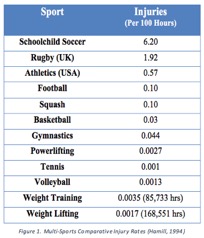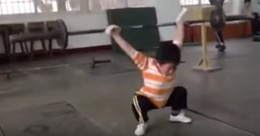Youth Strength Training FAQ

In the past 30 years’ childhood obesity in the US has more than doubled. The percentage of obese children (aged 6–11 years) in the United States is now 18% (as of 2012). Children are more inactive than ever, preferring to spend their free time playing video games instead of being outside, socializing, or exercising.
In addition, this ‘Xbox’ generation has developed shorter attention spans, postural issues, and other inactivity-related diseases.
Going to the gym to run on a treadmill or to cycle on a stationary bike is unlikely to appeal to most kids, it’s boring, there’s little obvious progression, and (especially for bigger kids) it’s very hard work. Strength training has been recommended for children as young as six by multiple, major professional organizations (including the American College of Sports Medicine, the National Strength and Conditioning Association, and the UK Strength and Conditioning Association, amongst others). However unfortunately common opinion is that it’s dangerous, stunts children’s growth, it’s pointless because they lack testosterone to get stronger, and will compromise their performance in other sports. These statements are false, and this FAQ will provide reasons why.
First off, there are numerous clear benefits of strength training. This type of training will result in improved self-esteem through positive changes in body composition and perceived body image, it’s also more accessible for bigger kids (compared to running, swimming, etc.) which will therefore allow them to experience success in a sporting environment. Getting the child active will reduce body fat, improve attention span, promote stronger social skills, and positively affect their mood. Strength training can also improve motor skill performance, enhance physical literacy, and strength bones, ligaments, and tendons, which will reduce their risk of injury.

Will strength training stunt my child’s growth?
Absolutely not, there is no evidence to indicate a decrease in stature in children who regularly strength train in a supervised environment with qualified instruction. Additionally, no growth plate damage has been reported in any research studies. In all likeliness, participation in weight-bearing/resistance training activities will have a positive influence on growth. The myth of strength training stunting growth came about due to people watching Olympic Weightlifting competitions and noticing that all the athletes were short, however this is simply a commonality of elite performers in the sport – to be successful you have to be short, the sport didn’t make the athletes shorter.

My child needs to be fast, won’t training with weights make them big and slow?
Maximal speed and maximal strength are both largely based around adaptations to the central nervous system, and therefore positively complement each other. In order to increase sprinting speed to their greatest potential, a young athlete should be training to improve both of these qualities.
I thought children couldn’t get strong because they don’t produce enough testosterone?
Testosterone is not essential for achieving strength gains. Children will make neural adaptations that will benefit their strength levels. Hypertrophy (muscle gain) is limited, but that doesn’t necessarily correlate with strength.
My child is too young to begin strength training, isn’t he/she?
As previously stated, strength training has been recommended for children as young as six years old by numerous organizations. In general, if you determine a child to be old enough to take part in organized sports, then they’re most likely ready to begin a progressive strength training program (this will also counter the fact that young athletes under-train and over-compete). Chronological age is inherently flawed as a way to determine readiness for training, as every child matures mentally and physically at different rates. It’s much more appropriate to use common sense and simple observation to determine this. Can they move well? Do they have enough of an attention span? Do they look ready to lift? Are they stable during basic movements?
Isn’t strength training dangerous?
Under proper supervision and ability-specific instruction, strength training is considerably less dangerous than most other common sports/activities.

Every time you do an activity, you are putting huge amounts of stress on your body:
- Walking = 1.5 x Bodyweight
- Running/Sprinting = 3-6 x Bodyweight
- Jumping = 4-11 x Bodyweight
By strength training we are increasing the child’s ability to cope with the demands (specifically forces) of whatever environment they’re in – whether it’s a sport, general ‘play’ activities, or simply walking to the bus stop. Young athletes in particular are suffering sports-related injuries because they are poorly-prepared for the demands of their sport. Up to 50% of youth sporting injuries could be prevented if more emphasis was placed on developing fundamental motor skills and fitness abilities before participating in a sport.
Strength training isn’t always about lifting super heavy weights, however at appropriate times healthy children should be exposed to heavier loads (when technically capable and under supervision). Working with heavy weights is often thought to be dangerous, particularly for a one repetition max (1RM) because it’s a single, all-out effort. However, this isn’t dissimilar to a football tackle, a throw, or a jump, and actually occurs in a much safer, less chaotic, and more controlled environment. Children with less than three/four years training experience are unlikely to attempt a 1RM, but instead may do a multi-rep max test (2-5RM) which would involve slightly lighter loads. What is considered heavy weight for a child? This depends on mental and physical maturity, training experience, and technical proficiency. And of course everything is relative to their existing strength levels.

References
https://www.cdc.gov/healthyschools/obesity/facts.htm
Faigenbaum, A. D., Kraemer, W. J., Blimkie, C. J., Jeffreys, I., Micheli, L. J., Nitka, M., & Rowland, T. W. (2009). Youth resistance training: updated position statement paper from the national strength and conditioning association. The Journal of Strength & Conditioning Research, 23, S60-S79.
Lloyd, R., Faigenbaum, A., Myer, G., Stone, M., Oliver, J., Jeffreys, I., & Pierce, K. (2012). UKSCA position statement: Youth resistance training. Professional Strength and Conditioning, 26, 26-39.
https://www.acsm.org/docs/default-source/brochures/physical-activity-in-children-and-adolescents.pdf
Hamill, B. P. (1994). Relative Safety of Weightlifting and Weight Training. The Journal of Strength & Conditioning Research, 8(1), 53-57.
Malina, R. M. (2006). Weight training in youth-growth, maturation, and safety: an evidence-based review. Clinical Journal of Sport Medicine, 16(6), 478-487.
But, P. (1993). Youth Injuries in Sports are Preventable. Sports Medicine Digest, 4-1.
